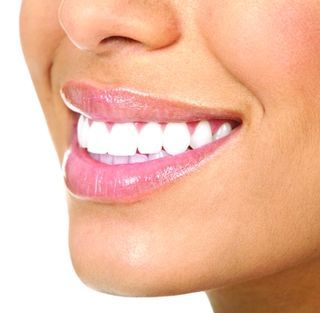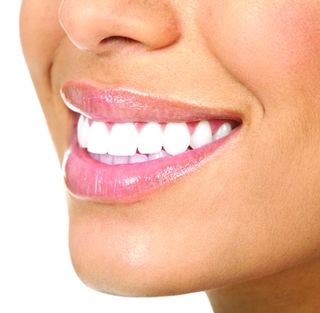
How to Soothe Sensitive Teeth After Whitening
What Causes Tooth Sensitivity After Whitening?
Sensitive teeth after bleaching happen for two reasons:
- Bleaching molecules penetrate into your teeth increasing blood flow and pressure in the tooth pulp causing mild pulpitis. Although diffusion into your teeth helps amplify whitening effects since chromophore molecules in your tooth dentin can be broken up by hydrogen peroxide, the increased pressure irritates the tooth nerve slightly and makes your teeth more sensitive to stimuli in general. Everyone responds differently and this mild pulpitis can last for about 2 weeks after teeth whitening.
- Increased tooth porosity and removal of the protective protein layer on the surface of your teeth. We talked about how maintaining the protein pellicle is important in keeping the pores in exposed dentin closed off from the oral environment. For better or worse, all whitening products must strip off this protein layer in order to dissolve surface stains. This will open up pores in exposed dentin and cause sensitivity.
How to Relieve Sensitive Teeth after Whitening
- Brush your teeth before whitening, not after whitening. Brushing right after whitening will further open pores on exposed dentin and create sensitivity. It can also damage your enamel since some bleaching agents are slightly acidic. Let your teeth recover afterward.
- (Optional) Use a Desensitizing Gel to calm the nerves in your teeth prior to whitening. For the most relief, you should apply the gel to your teeth for 10 to 30 minutes before bleaching using the same bleaching trays you got from your dentist and rinse afterward. Ideally, the gel should contain both 5% potassium nitrate and fluoride. Your dentist is able to prescribe specifically designed desensitizing gels like UltraEZ™, Desensitize!, and Relief™, but in a pinch, you can also try using in the trays a desensitizing toothpaste that contains 5% potassium nitrate. Using toothpaste instead of commercial gels may also be a more cost-friendly method. Some ingredients in the toothpaste though might irritate your gums a bit, and if that starts to happen stop and let your dentist know.
- Whiten as directed.
- Rinse out your mouth thoroughly after bleaching with water, or better still a pH re-balancing mouth rinse. Although bleaching companies try to make products that are pH balanced, many end up being slightly acidic. Getting your oral pH back to normal lets your teeth begin to recover.
- Use your finger (or q-tip) to gently apply to your teeth one of the Calcium-Based Desensitizing pastes we discussed last week. Let the paste set for a few minutes and then spit thoroughly; do not rinse for at least 30 minutes following application. By gently coating your teeth with a product like MI Paste or Colgate’s Pro-Argin Toothpaste, you will plug up open pores on your teeth and reduce sensitivity. Additionally, the remineralizing effects of these pastes help to improve teeth whitening.
Additional Tips to Prevent Tooth Sensitivity Caused by Whitening
- Do not use higher concentrations of bleaching agents than you need for the whitening results you want. The amount of pulpitis caused by the diffusion of bleaching molecules into your teeth is a function of the concentration of the hydrogen peroxide or carbamide peroxide in the bleaching product, and how much is able to enter the tooth. It is also important to keep in mind when examining bleaching concentrations that carbamide peroxide is about ⅓ as strong as hydrogen peroxide.
- You can opt to use Crest White Strips instead of Tray or In-Office bleaching if you don’t need additional whitening. Although Tray Bleaching and In-Office Bleaching offer many advantages, they allow more bleaching molecules to enter your teeth. Teeth Whitening Strips, on the other hand, don’t allow many bleaching molecules to enter your teeth because of their design, and this means that you will have less sensitivity. So teeth sensitivity after whitening strips is comparatively less.
- Do not leave in bleaching trays for longer than directed.
- Modify your diet to limit acids during active whitening periods. If you do a one-step in-office whitening this really only applies to the first day or two after whitening, but this is more important if you are in the middle of two weeks of using Crest White Strips. Bleaching therapies of all kinds lift the protein pellicle off your teeth making your teeth more vulnerable to acids during this time. With the pores on exposed dentin already more open to the oral cavity because of bleaching, you don’t want acid erosion from foods or drinks to make this worse.
- Anti-inflammatories like Ibuprofen can be helpful for sensitivity if taken prior to teeth whitening, but the effect doesn’t last more than a couple of hours so you’ll have to take more. To work as they should, you should take 600mg of Advil (Ibuprofen) about an hour before bleaching. Consult your doctor before taking any medication.
For those looking for a premium whitening experience, schedule your teeth whitening or smile fresh program appointment today and let your confidence shine through